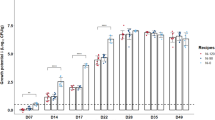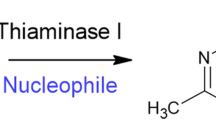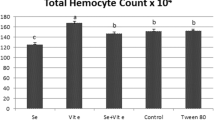Abstract
DURING feeding experiments we have found that 0.5 percent methionine in a semisynthetic diet containing 12 per cent cod liver oil prevents yellow discoloration of the diet and also the destruction of vitamins A and E (refs. 1–3). We have also studied the antioxidant properties of methionine and some derivatives using simple manometric techniques4 and have recorded the near infrared spectrum of CCl4 extracts of the semisynthetic diet. The spectrophotometric data showed a relatively constant peak at 2.34µ and a variable peak at 2.88µ which increased as oxidation progressed, permitting use of the ratio of absorptions at these two wavelengths as an additional measure of oxidation. Using both criteria hydrochlorides of the methyl and ethyl esters of methionine showed unique properties. In contrast to other compounds which were tested there were rapid but relatively small initial changes followed by extended periods in which only very slow changes took place. The esters therefore seemed to be transformed to antioxidant compounds acting in a similar way to butylated hydroxy toluene (BHT).
This is a preview of subscription content, access via your institution
Access options
Subscribe to this journal
Receive 51 print issues and online access
$199.00 per year
only $3.90 per issue
Buy this article
- Purchase on Springer Link
- Instant access to full article PDF
Prices may be subject to local taxes which are calculated during checkout
Similar content being viewed by others
References
Årsberetn. Norg. Fisk., No. 3 (1965).
Njaa, L. R., Myklestad, H., Utne, F., and Brækkan, O. R., Tidsskr. Kjemi, Bergv., Metall., 25, 290 (1965).
Njaa, L. R., Tidsskr. Kjemi, Bergv., Metall., 26, 151 (1966).
Astrup, H., Herring Oil and Meal Research Institute, Report No. 52 (Bergen, 1957).
Stull, J. W., Herreid, E. O., and Tracy, P. H., J. Dairy Sci., 34, 187 (1951).
Akagi, M., and Aoki, I., Yakugaku Zasshi, 77, 1314 (1957). cited in Chem. Abstr., 52, 6263e (1958).
de Brochard, J. P., Veyron, J., Froment, H., and Randelli, P., Patent Fr. 1.110.038 (February 6, 1956), cited in Chem. Abstr., 53, 6482h (1959).
Marcuse, R., Fette Seifen, 63, 547 (1961).
Barnard, D., Bateman, L., Cole, E. R., and Cunneen, J. I., Chem. Indust., 918 (1958).
Bateman, L., Cain, M., Colclough, T., and Cunneen, J. I., J. Chem. Soc., 3570 (1962).
Cain, M. E., and Cunneen, J. I., J. Chem. Soc., 2959 (1962).
Author information
Authors and Affiliations
Rights and permissions
About this article
Cite this article
NJAA, L., UTNE, F. & BRÆKKAN, O. Antioxidant Properties of Methionine Esters. Nature 218, 571–572 (1968). https://doi.org/10.1038/218571a0
Received:
Revised:
Published:
Issue Date:
DOI: https://doi.org/10.1038/218571a0
This article is cited by
-
Reaction of histidine with methyl linoleate: Characterization of the histidine degradation products
Journal of the American Oil Chemists' Society (1978)
Comments
By submitting a comment you agree to abide by our Terms and Community Guidelines. If you find something abusive or that does not comply with our terms or guidelines please flag it as inappropriate.



